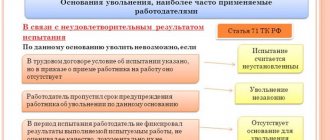Hello! In this article we will talk about such a concept as an employee’s personal file.
Today you will learn:
- What is called a personal file and in what cases should it be kept;
- What documents should be contained in it;
- How much and how to store files.
Not all categories of employers are required to maintain personal files of their employees. But for the effectiveness of team management, it is advisable to form them. Today we will discuss how to do it correctly.
Content
- Personal file: what is it and why keep it
- Who should I register for?
- Who has access to business
- Providing cases to law enforcement agencies
- Registration of a personal file
- What should be in an employee's personal file
- Samples and forms of documents for personal files
- Order of business
- Logbook: how to keep it
- Electronic personal file
- How to deal with the affairs of dismissed employees
- Conclusion
What are the nuances?
When creating personal files, the following nuances must be taken into account:
- they must be kept for each employee signed under an employment contract, regardless of the period of his work;
- if the same employee works in an organization in several positions, that is, he is registered under an internal part-time contract, a personal file is opened for each position;
- if an employee was fired and then hired again by this organization, then a personal file must be opened again;
- As a rule, the personal file contains copies of personal documents (in particular, a passport with a photo), so the HR officer must necessarily draw up an agreement with the employee for the processing of personal data;
Video - consent form for the processing of personal data:
- Personal files are not kept for employees registered under a civil contract.
- The work book is not kept in the personal file; a separate storage procedure is provided for it. But you can include a copy of it in it, this is especially true when work books are stored in a higher organization, and personal affairs are maintained in separate departments.
Personal file: what is it and why keep it
First of all, this is a set of documentation that characterizes the employee’s activities at a specific workplace. The case is considered initiated from the moment the first document appears in it. Management is usually carried out by the HR department, less often by the accounting department.
Often a personal file is placed on the same level as a work record book, although this is wrong. The work book does not contain any information other than the past and present place of work, unlike the dossier.
The composition of the personal file changes and is supplemented as the person carries out his work activity.
Who should I register for?
It is mandatory to maintain personal files for those employed in the state civil service. This is required by Russian legislation. Entrepreneurs can regulate this issue by local regulations. This means that HR department employees can only open personal files for key employees.
This group includes:
- Management staff and their replacements;
- Chief specialists;
- Persons who are responsible for property and valuables;
- Employees with prospects for career advancement.
But still, it would be useful to create such dossiers for all employees, since they reflect information about employees that may be required at any time.
Who has access to business
Only the personnel officer or accountant appointed by order of the manager enters information and submits files to the archive. If confidential information is leaked from the case, all responsibility for this will fall on this person.
To avoid such unpleasant situations, it is better to store personal files in a specially designated room, or in safes and metal cabinets, to which third parties cannot gain access.
In addition, the responsible person is obliged to familiarize each employee with his personal file at least once every 12 months.
Registration of a personal file
Watch a short video on how to register an employee’s personal file and everything will become clear:
Before we talk about managing personal affairs, let’s take a closer look at how to formalize them correctly. The formation of a case begins from the date a person is hired and continues until the moment of his dismissal. For each task, it is better to take a separate folder, or at least a file.
When an HR employee creates a personal file, he must remember that:
- It is better to replace original documents with photocopies, in order to avoid a situation where the original of an important document is lost (there are often cases when original diplomas are lost, and it is not easy to restore them);
- One copy of each document is included in the file;
- Documentation of temporary storage and permanent storage are not stored together;
- It is better that one case does not exceed 4 cm in thickness;
- It is better to keep applications in the same place as documentation.
All personal files should be prepared in the same way, and a log of personal files should be kept in order to avoid the loss of important documentation.
So, a sample of a personal file:
- The cover of the personal file contains the surname and initials of the employee, the date when the case was started;
- If there are no separate folders for storing things, then it is better to place them in one folder in alphabetical order;
- The number of pages should not exceed 250;
- Each folder is marked with a case number.
Is it necessary to keep personal files?
Most entrepreneurs consider personal files an essential component of personnel documentation. However, the law states that this is only true for civil servants.
Personal files for government employees
Information about state and municipal employees must be systematized in the prescribed form (Decree of the President of the Russian Federation of May 30, 2005 No. 609). The personnel files of such employees are intended to reflect their entire track record so that it can be clearly seen how exactly their personal data has changed.
If an employee moves from one structure to another, his personal file must follow.
At a new place of work, it will be easier to form an impression of a new person, as well as obtain additional information about sources of income, connections, professional network, as well as other information that facilitates control.
Federal Law No. 79-FZ “On the State Civil Service of the Russian Federation” dated July 27, 2004, in Part 3 of Article 42, reveals the procedure for all actions with the personal files of this category of employees.
How to draw up an act of acceptance and transfer of the personal file of a municipal employee ?
Personal affairs of entrepreneurs
Neither the Labor Code nor other regulations of the Russian Federation contain a mandatory requirement to maintain personnel documentation exclusively through personal files created for each employee. Therefore, such registration of personnel data is not at all mandatory or even recommended.
IMPORTANT! The laws of the Russian Federation do not prohibit legal entities or individual entrepreneurs from maintaining personal affairs for their employees.
If the management of an organization or individual entrepreneur has decided to make it mandatory to fill out personal files, this must be enshrined in the accounting policy by prescribing the procedure in internal regulations. As a rule, it is the case that they use the regulations developed for civil servants.
Advantages of the personal affairs system for an entrepreneur
Despite the fact that no requirements define or limit the composition of a personal file and the procedure for maintaining it, the practice of this branch of office work shows the undoubted convenience for the manager of this form of storing personal information. It is for this reason that the ubiquity of personal files in the personnel service has formed the myth of their obligatory nature.
The positive effect of introducing personal personnel records is obvious:
- timely recording of all employee documentation;
- tracking career dynamics;
- recording data on possible benefits;
- assessment of prospects for professional growth;
- safety and orderliness of personal documentation;
- prompt access to the entire range of personnel information.
What should be in an employee's personal file
The composition of a personal file is not regulated at the level of regulations. It is strictly approved only for the state. employees. Any organization can use the approved list and decide which documentation to include in the files of its employees and which not.
The list is:
- Photocopy of passport (most often the first page, marital status and place of registration);
- A photocopy of a diploma, advanced training document, etc.;
- Photocopy of SNILS;
- If the employee is liable for military service - a copy of the document confirming this;
- Photocopy of TIN;
- Documentation of passing a professional examination and medical examination (if this is provided for by the company’s activities);
- A certificate stating whether the citizen has a criminal record or lack thereof (if provided for by law);
- A job application written by the employee personally;
- Autobiography;
- A copy of the employment contract;
- A photocopy of the work record;
- Materials about certification (if carried out);
- Employee photographs that are periodically updated;
- Description of personal file.
This list may change and be supplemented, depending on what activities the company conducts and what personnel policy it implements.
In addition, all documents must be placed in the file in chronological order: the very first ones that were included when the person was hired, then those that appeared during his activity.
It is prohibited by law to include in the file information about the personal life of an employee, about his views on politics and religion, if he did not give written consent to this.
Formation of an employee’s personal file
Since a personal file is one of the HR documents, when preparing it you must adhere to the following rules:
- all documents contained in the personal file must be neatly executed and properly secured;
- documents that involve entering data into them (personal card, orders, etc.) should not contain corrections or errors; they cannot be drafts. Entries in such documents can be made by hand or using a computer;
- The LD, which stores copies of the employee’s individual documents, such as an employment contract, must be stored in a place inaccessible to unauthorized viewing of the documents contained in it.
As a rule, all documents in a personal file are filed in a binder or stored in a folder with drawstrings, and they must be located in the sequence established by the instructions.
What should it contain
The personal file may include the following documents:
- personal card form T-2, and it must be created for each employee, regardless of whether personal files are formed at the enterprise;
- copies of personal documents that the employee provides when applying for a job (passport, SNILS, Taxpayer Identification Number, diploma, military ID);
- employee application for employment;
- one copy of the employment contract and additional agreements thereto;
- a copy of the employment order;
- statements and copies of orders reflecting the employee’s movements within the organization (change of job title, transfer, etc.);
- documents evidencing the employee’s right to perform the work assigned to him (driver’s license, medical certificates);
- notes on penalties and awards received by the employee;
- a copy of the dismissal order;
- resignation letter or other document that served as the basis for termination of the employment contract.
Video - composition of a personal file:
Employee personal card in form T-2
As mentioned above, a personal card is a document that must be issued for each employee.
The unified T-2 form is filled out when hiring an employee and contains all the necessary information:
- all personal data of the employee;
- about the employee’s education;
- about the employee's length of service;
- about relatives;
- about place of residence;
- about military registration;
- about work and its changes;
- information about advanced training or training with this employer;
- information about employee vacations;
- information about dismissal.
That is, the personal card contains almost all the information that may be useful in the course of work for a personnel officer or accounting department. Therefore, many employers limit themselves to maintaining this form, into which they simply attach copies of documents. Without indicating in internal documents that it is necessary to create personal files at the enterprise and without regulating the procedure for maintaining them.
Video - how to fill out an employee’s personal card in form T-2:
This will not be a violation, since during the check they only pay attention to the presence of a correctly executed T-2 card.
Order of business
This process includes:
- Making entries in the relevant sections;
- The procedure for removing documentation that has become irrelevant or is no longer needed;
- Checking personal files for the safety of documentation;
- Storing documentation as part of a personal file.
If an employee's personal information changes, they usually report this to the HR department. It is better, of course, to do this in writing. After the HR department employee makes the appropriate entry into the file, the original document is returned to the employee. If necessary, you need to make a copy of the document and attach it to the file.
All entries are made only based on original documentation or copies certified by a notary. Entries are made by hand in black, blue or purple ink, carefully, avoiding blots and corrections. If necessary, the records are certified using the organization’s seal and the signature of the HR department employee.
It is not recommended to use gel pens for writing, as this type of ink is subject to rapid fading.
All sheets that are filed in the file are numbered. And the numbering is reflected in the internal inventory. Such an inventory is compiled to take into account documents that have been stored for more than 10 years.
If the case is being prepared for submission to the archive, all sheets of the internal inventory are also numbered, only separately from the sheets of the case.
To lead or not to lead: what does the law say?
Today, many issues are being discussed, among which the most common are two controversial issues:
- does the employer need personal files of employees and what documents should be included there;
- Is it possible to legalize the storage of copies of personal documents of employees, which are often required by external supervisory authorities or other authorized organizations.
The direct obligation of the employer to maintain personal files of employees is established for state, civil, municipal and other employees.
It is believed that other employers do not have to keep personal files of employees, because There is no direct indication of this, but this is an incorrect judgment.
There are many existing documents of the Soviet period of legal regulation and modern legal acts that require the storage in the employee’s personal file of a number of documents accompanying or generated during labor relations, for example:
- “ Methodological recommendations for working with documents on personnel in state and municipal archives, archives of organizations
” (developed by VNIIDAD, the text of which is available on the website https://archives.ru/ as of March 26, 2019) in clause 2.1. defines “Personal file as a systematized set of personal and primary accounting documents characterizing the work activity of a particular employee. The personal file is opened at the time the employee starts work and ends with the date of his dismissal. Documents in the personal file are arranged in accordance with the chronology of their creation, but the first and last are certified copies of orders on the hiring/dismissal of an employee.”; - Order of the Ministry of Culture of Russia dated August 25, 2010 N 558 “On approval of the “List of standard management archival documents generated in the process of activities of state bodies, local governments and organizations, indicating storage periods””, paragraph 656 establishes the need to store personal files of almost all employees of a legal entity.
- Federal Law of October 22, 2004 N 125-FZ “On Archival Affairs in the Russian Federation”, which, in paragraph 3 of Article 3, defines a separate concept of archival affairs in the Russian Federation as “documents on personnel - archival documents reflecting the labor relationship of the employee with the employer.”
Considering that documentation technology and labor relations are regulated by various legal and legislative acts, which should be implemented equally, we have to recognize the need for maintaining personal files of employees as practically proven.
Other, including departmental, legal acts that oblige the inclusion of certain types of documents in personal files deserve special mention, namely:
- “ Instructions for personnel registration in bodies, institutions and enterprises of the system of the USSR Ministry of Health
” (approved by the USSR Ministry of Health on November 24, 1955) pp. 23-28 not only determines the need to maintain personal files of employees, but also the rules for its registration and storage; - “ The list of documentary materials generated in the activities of the State Forestry Committee of the Council of Ministers of the USSR and the bodies of its system, indicating the storage periods for materials
” (approved by the State Forestry Agency of the USSR on 01.08.1969, by the Main Archive of the USSR on 07.08.1969) in paragraphs 486 and 487 establishes the need to store personal files scientific staff and teaching staff of research and educational institutions; personal files of workers and employees for a certain period of time, but not less than 75 years; - “ The list of documentary materials generated in the activities of the Ministry of Geology of the USSR and institutions, organizations and enterprises subordinate to it, indicating the storage periods for materials
” (approved by the USSR Ministry of Geology on 04/17/1970, by the USSR Main Archive on 06/09/1970), paragraph 781 establishes the need to store personal files of engineering and technical workers and office workers 75 years old; - “ List of documents with storage periods for the Ministry of Culture of the USSR, its institutions, organizations and enterprises
” (approved by the Ministry of Culture of the USSR on 03/21/1983, by the Main Archive of the USSR on 03/31/1983) establishes different storage periods for personal files of various categories of workers and citizens; - Resolution of the State Committee for Science and Technology of the USSR N 470, State Committee for Labor of the USSR N 267 of 10/05/1973 (as amended on 11/14/1986) “ On approval of the Regulations on the procedure for certification of management, engineering and technical workers and other specialists of enterprises and organizations of industry, construction, agriculture, transport and communications
" (together with the "
Standard list of positions of management, engineering and technical workers and other specialists in industry, construction, agriculture, transport and communications and other sectors of the national economy, subject to certification in accordance with the Resolution of the Council of Ministers of the USSR of July 26, 1973 N 531
", approved by Resolution of the State Committee for Science and Technology of the USSR, State Committee for Labor of the USSR dated October 22, 1979 N 528/445), paragraph 10 obliging the certification sheet and review (characteristics) of the employee who has passed the certification to be kept in his personal file; - Order of the Ministry of Housing and Utilities of the RSFSR dated 08/04/1981 N 420 “ On the approval and implementation of the “Rules for the technical operation of hotels and their equipment
” approves not only the form of the checklist for completing safety training, but also determines the place of its storage - in the employee’s personal file; - Order of the Ministry of Social Security of the RSFSR dated November 22, 1982 N 109 “ On approval of the Instructions on the procedure for conducting documentary audits of the financial and economic activities of budgetary institutions, organizations and statutory subsidiary agricultural enterprises of the system of the Ministry of Social Security of the RSFSR
”, paragraph 10.3 establishes the procedure for checking the correctness of tariffs, which “is checked against the available in the personal files of employees, documents (orders, work books, copies of diplomas, certificates of completion of educational institutions and other certificates). The procedure for compiling tariff lists is given in the instructions (see Appendix No. 1)"; - Letter of the Ministry of Education of the Russian Federation dated September 29, 2000 N 711/28-16 “ On the approximate nomenclature of affairs in an educational institution for additional education of children
”, specifies in paragraph 5 the personal files of employees to be kept for 75 years.
Order of the Ministry of Education of the RSFSR dated 09.20.1988 N 41 “ On the documentation of preschool institutions” (together with the “Approximate nomenclature of files of a children’s preschool institution
”, “
Recommendations for the application of the Approximate nomenclature of files of preschool institutions
”), paragraph 04-05 determines the storage period for personal files of employees of these institutions - 75 years; - Order of the State Construction Committee of the Russian Federation dated January 20, 2000 N 8 “ On approval of the Regulations on the procedure for certification of managers and specialists of technical inventory organizations
”, paragraph 30 includes certification sheets of all certifications, the employee’s performance characteristics as part of the documents of his personal file, which should be stored in accordance with existing regulatory deadlines storage of these documents; - “ Program of annual training for drivers of motor transport enterprises.
RD-26127100-1070-01 " (approved by the Ministry of Transport of the Russian Federation on October 2, 2001) includes information about training and the results of the final test in the driver’s personal file.
A similar requirement for inclusion in personal files of written obligations of employees related to the operation and maintenance of rolling stock of road transport is contained in paragraph 8 of Order of the Ministry of Automobile Transport of the RSFSR dated December 9, 1970 N 19 “ On approval of the Rules for the technical operation of rolling stock of road transport
”; - Order of Rosmorrechflot dated November 1, 2011 N 218 “ On the formation of a reserve of management personnel of institutions subordinate to Rosmorrechflot
”, paragraph 18 requires that a written report of an employee enrolled in the reserve be attached to the personal file.
The argument for the need to maintain personal files in the form of a list of documents provided is extensive, but not finite. The ConsultantPlus information base contains many more similar requirements in the relevant eligible documents.
Some opponents, referring to the Labor Code of the Russian Federation, cite as evidence of the unnecessaryness of personal files the absence in the Labor Code of the Russian Federation of requirements for the employer to maintain an employee’s personal file, but we will be precise in the enforcement of the said federal law.
Article 1 of the Labor Code of the Russian Federation dated December 30, 2001 N 197-FZ refers to “legal regulation of labor relations and other relations directly related to them by:
- labor organization and labor management;
- employment with this employer;
- training and additional professional education of workers directly from this employer;
- social partnership, collective bargaining, conclusion of collective agreements and agreements;
- participation of workers and trade unions in establishing working conditions and applying labor legislation in cases provided for by law;
- material liability of employers and employees in the field of labor;
- state control (supervision), trade union control over compliance with labor legislation (including legislation on labor protection) and other regulatory legal acts containing labor law standards;
- resolution of labor disputes;
- compulsory social insurance in cases provided for by federal laws,” rather than documenting labor relations.
To document labor relations and store labor relations documents, other legal acts are applied, such as:
- - “State system of documentation support for management. Basic provisions. General requirements for documents and documentation support services" (approved by the board of the USSR Main Archive on April 27, 1988, Order of the USSR Main Archive dated May 25, 1988 N 33) (together with the "Rules for filling out the basic details of registration and control forms (RKF)", "Approximate regulations on the service documentation support for management"): M., Main Archive of the USSR, 1991;
- - “OK 011-93. All-Russian Classifier of Management Documentation" (approved by Resolution of the State Standard of Russia dated December 30, 1993 N 299);
- - the above in the text and other legal acts.
Considering that the procedure for documenting processes in a legal entity is determined by its sole executive body in accordance with the current regulatory documents of ministries and departments on issues of documentation support for management (for example: Order of the Federal Archive of April 11, 2018 N 44 “ On approval of the Model Instructions for Office Work in State Organizations
"(Registered with the Ministry of Justice of Russia on August 17, 2018 N 51922) contains the general procedure for creating a case without determining whether it belongs to the storage fund) the procedure for creating and types of documents in the personal files of employees should be determined by a local regulatory act of the enterprise.
Logbook: how to keep it
It is necessary to take into account personal files opened for employees. Its standard form has not been approved, which means you can take a sample from the Internet or purchase it in a store. The content of each column can be changed depending on the organization.
The log contains: case numbers, their start date, surname and initials of employees and other information. When a personal file is closed, a note is made in the journal: they put a date and enter the reason why the case was closed.
Additional information is usually entered in the “Other” or “Notes” column.
Electronic personal file
Nowadays, many Russian companies have implemented or have begun to implement HR automation. It can hardly be called following fashion, rather a necessity. Employees' personal files are increasingly maintained and stored in computer databases. Paper documents are used, but mostly as reinsurance.
Maintaining and storing personal files in electronic form is, above all, convenient. A HR employee does not need to bite the dust, shifting things around in order to find what he needs. Therefore, one of the absolute advantages of electronic files is the ability to find everything quickly, without wasting time and effort.
It is worth noting that not all documentation can be kept in electronic form; work books, for example, cannot.
If the document must contain the personal signature of the employee, it must also be in paper form.
How to deal with the affairs of dismissed employees
When a person quits, his file is closed, removed from the file and filed. In this case, a certification sheet must be drawn up. It includes data on how many sheets are stitched and numbered. This sheet also indicates whether there are damaged documents in the case, or whether new ones have been attached.
The certification sheet is pasted onto the cover of the case from the inside. The HR employee puts his signature on this sheet.
An employee’s personal file is kept in the archive for 75 years; for managers, this period is usually longer. But at the same time, if on the last working day an employee asks for copies of the necessary documents, this can be done; in this case, the file will not have to be stored, and the archive will be unloaded.
Managing personal affairs
The procedure for maintaining personnel documentation must be set out in detail in the relevant Regulations adopted by the company. It may provide for a number of accounting procedures:
- Registration. In large organizations, a special journal or book is created to record personal affairs. Each new case is entered into it under a certain number (code), the same sequence of numbers is affixed to the folder with the case itself. The journal may also contain the following information about a personal file:
- Full name of the employee;
- establishment date;
- closing date;
- date of transfer to the archive.
- Adjustment . It is necessary if, during the employment process, the employee’s personal data has undergone significant changes: place of residence, social status due to marriage or divorce, change of surname, etc. Changes are made based on the attachment of relevant documentary evidence (copies of marriage certificate, birth certificate, etc.). Only a responsible employee appointed by a special order, or another officially authorized to replace him, has the right to make changes.
- Storage. Since personal data is confidential information, folders must be stored so that they cannot be accessed by unauthorized persons. Typically a safe or locked cabinet is used for this purpose. Only files of active employees should be kept. After dismissal, the employer retains the case for some time (he sets this period himself; in the civil service, if the case is not transferred to another body, it is 10 years).
- Transfer to the archive. The case of the dismissed employee must be closed and, upon expiration of the internal savings period, transferred to archival storage. To transfer, you need to fill out a certification sheet , where final information about the state of your personal file is entered. This sheet is filed at the end of the folder. From the moment the file is transferred to the archive, it will be stored there for 75 years if it belonged to an ordinary employee, and permanently if it belonged to a manager.
NOTE! If an error, inaccuracy or consequence of a change is corrected, this should be done by analogy with work books: cross out the incorrect one with one line, write the correct version at the top, and in the margins put a note about the correctness of the correction and its date.
What form should be used to keep a log of personal files of employees ?









